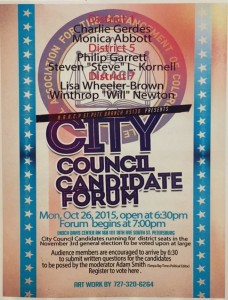BY SAMANTHA PRITZLAFF
NNB Reporter
Winthrop “Will” Newton is vying for the District 7 City Council seat against Lisa Wheeler-Brown Nov. 3.
Newton is currently the district vice president for Florida Professional Firefighters in Pinellas and Pasco counties. The job takes him to Tallahassee to negotiate with lawmakers on behalf of firefighter unions.
“I’ve committed my life to keeping people safe and solving complex problems for more than two decades,” said Newton.
Public safety is just one of Newton’s priorities. His campaign also focuses on education, new and growing businesses, youth programs and in supporting taxpayers’ interest in the on-going issue regarding stadium lease with the Tampa Bay Rays at Tropicana Field.
Both Wheeler-Brown and Newton share similar goals. However, they split on the Rays issue, in which Wheeler-Brown favors the team moving outside of St. Petersburg.
City Council voted 5-3 last Thursday (Oct. 22) on a deal that would allow the Rays to potentially end their lease early and seek a stadium elsewhere, according to the Tampa Bay Times. The plan, if accepted by the Rays, could cost the team $33 million if they left before 2020, according to the Tampa Bay Times.
When it comes to moving forward with these priorities, Newton insists on his strong ability and desire to work, “collectively and collaboratively” with other City Council members.
“My goal is to work with those folks that are on council, all of them, and in the end to be able to achieve those goals and priorities I’ve identified,” said Newton.
Wengay Newton, Will Newton’s brother, currently holds the District 7 City Council seat and will step down after serving his two-term limit.
When asked what he can bring new to the table, Newton says his track record and list of endorsements speaks for itself.
“I’m a tough negotiator, but once we reach a point, I know when to extend my hand across the table and shake that person’s hand and say, ‘Hey, we have a deal,’” said Newton.
Newton’s endorsements include former Mayor Rick Baker, current City Council members Bill Dudley, Amy Foster, Steve Kornell and Wengay Newton, along with Councilmember-Elect Ed Montanari. The Tampa Tribune, St. Petersburg Firefighters Association and the Suncoast Police Benevolent Association also endorse Newton’s candidacy.
District 7 hosts many residents living at or below the poverty level in areas of Southern St. Petersburg, such as Midtown and Childs Park. For Newton, this election goes beyond the borders of District 7.
“Any time one of the issues is improved, then we all are improved as a city collectively,” Newton says.
As a native to St. Petersburg, Newton worked as a St. Petersburg fire fighter EMT for 23 years. He is also a former president of the Childs Park Neighborhood Association.
For a complete list of all the candidates and poll locations, visit votepinellas.com.
